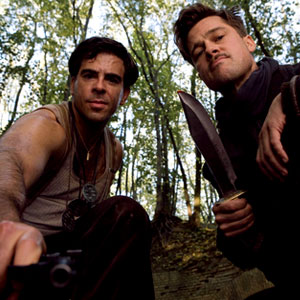Just from the title itself, the film Inglourious Basterds can either be pointed out as one of two definitions: a dumb film or an English one. A dumb film meaning that the characters might be portrayed as illiterate not being able to spell properly, or an English film because from pronouncing the words they seem to come out like how the English people would say it.
The film was parted into 5 chapters, sort of like in a book but the way they are told seems to be different stories and different perspectives of characters whose lives are somehow intertwined.
Technicalities of the film supported its humorous genre. The silly music, crazy back stories, odd characters, random texts, informal transitions per chapter are just some of the technical elements that showed how this movie may not be a reliable source of German Nazi-Jew facts, but can be a source of a good laugh and a lighter take on the holocaust. The reason why Tarantino chose to transform such a tragic event in history into such a laugh can never be fully known by others, but one thing’s for sure, it is different.
Tarantino moved away from the usual plot of holocaust movies where it shows how Jews were so oppressed by Nazis and women were powerless. He made the movie interesting by doing this. Turning the tables around and giving the oppressed side the upper hand in his movie. Shosanna, the French Jew, is an example of the table turner in this film. She had a huge role in the elimination of the top Nazi men and at the same time raises the flag of women. Tarantino shows her as the dainty, very feminine woman who looks like she can’t hurt a fly, but her character is strengthened when she starts to discuss her plans of killing the Nazis without any hint of doubt – not typical for women then.
Consistent with its goal of being different, the film was successful in this even when showing gory and gut twisting scenes. Tarantino was able to make the audience laugh with such scenes, opposite to the usual feeling of disgust when watching other World War II films. Another difference it makes is how lax it seems. There is no feeling of extreme eagerness to find out what will happen next, just pure leisure and amusement while watching the film. You won’t even notice that it lasts for more than 2 hours.
Aside from the obvious change in the story line of history, you won’t fail to take note of the comical characters. Even the most devilish of them, SS Colonel Hans Landa, despite being cruel can still be viewed with a light heart due to his charm and seemingly twisted way of thinking especially evident at the end of the film when he turned his loyalty to the other side and betrayed the Germans.
The movie may seem to appear as a joke in terms of history, attention to detail was certainly not overlooked by Tarantino. There is obvious care given to the production of the film which were shown by the use of props, clothing, and language especially. So you can’t really say that this movie is trash or a waste of time, there must be a deeper reason as to why Tarantino made such a film. Or else they wouldn’t even waste time trying to get their languages right.
Having read up on some articles regarding Tarantino and his previous films and how maybe he wants to achieve a ‘revolutionary art’ or an anti-fascist film, then I think he is successful in doing this given all the negative reaction he received. It can certainly cause a stir in a lot of fascists. He really was able to turn the table around in this film, sort of ‘showing’ the fascists how it feels. But personally, I am not a fan of gory movies and did not enjoy the head carving, scalping, and nut-shooting scenes. Fascists or anti-fascists, violence is violence. No matter who the giver and receiver of pain is, violence is still not a solution for me.



